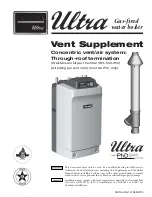
GT INSTALLATION AND OPERATION INSTRUCTIONS
Page 6
The vent terminal shall not terminate:
• Directly above a paved sidewalk or a paved drive-way
that is located between two buildings, and that serves
both buildings;
• Less than
7 ft
,
2.1 m
above grade where located
adjacent to a paved driveway or public walkway.
• Within
3 ft
,
0.9 m
, horizontally of a window or door that
can be opened, or non-mechanical air supply inlet to
any building.
• Within
6 ft
,
1.8 m
, of a mechanical air supply inlet to
any building or roof eve containing soffi t openings.
• Above a meter/regulator assembly within
3 ft
,
0.9 m
,
horizontally of the vertical centerline of the regulator.
• Within
6 ft
,
1.8 m
, of any gas service regulator vent
outlet.
• Less than
30 in
,
762 mm
, plus snow allowance above
grade, or any surface that will support snow, ice, or
debris.
The exhaust must be a minimum of 18 in,
457 mm
, above the air inlet, and the air inlet must
always be a minimum of 12 in,
305 mm
. plus snow
allowance above any surface that will support
snow. A 24 in,
610 mm
, plus snow allowance is
highly recommended. Consult your weather offi ce,
for the maximum typical snowfall for your region.
• Underneath a verandah, porch, or deck.
• So situated that the fl ue gases are directed towards
brickwork, siding, or other construction, in such
a manner that may cause damage from heat or
condensate from the fl ue gases.
• Less than
3 ft
,
0.9 m
, from an inside corner of an
L-shaped structure including walls and fences.
Under normal operating conditions this appliance will
produce a plume of water vapor, and should be taken
into consideration when selecting an adequate vent
terminal location. A
3 ft
,
0.9 m
, diameter stainless,
plastic, or vinyl shield can be used to fl ash the exterior
of the residence to protect is from damage.
Separate Air Intake and Vent Terminals
It is highly recommended that the air intake and vent
terminals not be located where they will be exposed to
normal prevailing winds. Both terminals must be on the
same wall.
The vent ter minal must be a minimum of
18 in
,
457 mm
above the air inlet terminal. The air inlet terminal
must always be a minimum of
12 in
,
305 mm
, plus the
snow allowance above any surface that will support
snow, however a snow allowance of two feet is highly
recommended Figure 5, 6, 7 & 8.
Consult your weather office for the maximum typical
snowfall for your region. For example, in Boston MA the
maximum typical snowfall is
12 in
,
305 mm
. Therefore
the inlet must be
24 in
,
610 mm
, above any surface
that will support snow and the exhaust must be 42 in,
1067 mm
, above this surface.
The horizontal centerline distance between the inlet
and exhaust terminals must be a minimum of
4 in
,
102 mm
. If the horizontal distance between the inlet
and exhaust is more than
12 in
,
305 mm
, increase the
vertical separation by the same amount to prevent fl ue
gas recirculation.
For example, if the horizontal separation is
24 in
,
610 mm
, a minimum ver tical separation of
18 in
,
457mm
, +
12 in
,
305mm
, =
30 in
,
762 mm
is required,.
If the horizontal distance is greater than
6 ft
,
1.8 m
,
no additional vertical spacing is required. The vertical
separ-ation is never required to be greater then
36 in
,
914 mm
.
Figure 5 - Horizontal Terminal Locations
Содержание GT-150
Страница 19: ...GT INSTALLATION AND OPERATION INSTRUCTIONS Page 19 Figure 30 Multiple 4 Wire Zone Valves...
Страница 22: ...GT INSTALLATION AND OPERATION INSTRUCTIONS Page 22 Figure 33 Boiler Ladder Diagram...
Страница 23: ...GT INSTALLATION AND OPERATION INSTRUCTIONS Page 23 Figure 34 Boiler Connection Diagram...
Страница 38: ...GT INSTALLATION AND OPERATION INSTRUCTIONS Page 38 Figure 48 Replacement Parts Exploded View SIOM 36...
Страница 40: ...WESTCAST INC 260 NORTH ELM STREET WESTFIELD MA 01085 TEL 413 562 9631 FAX 413 562 3799...







































